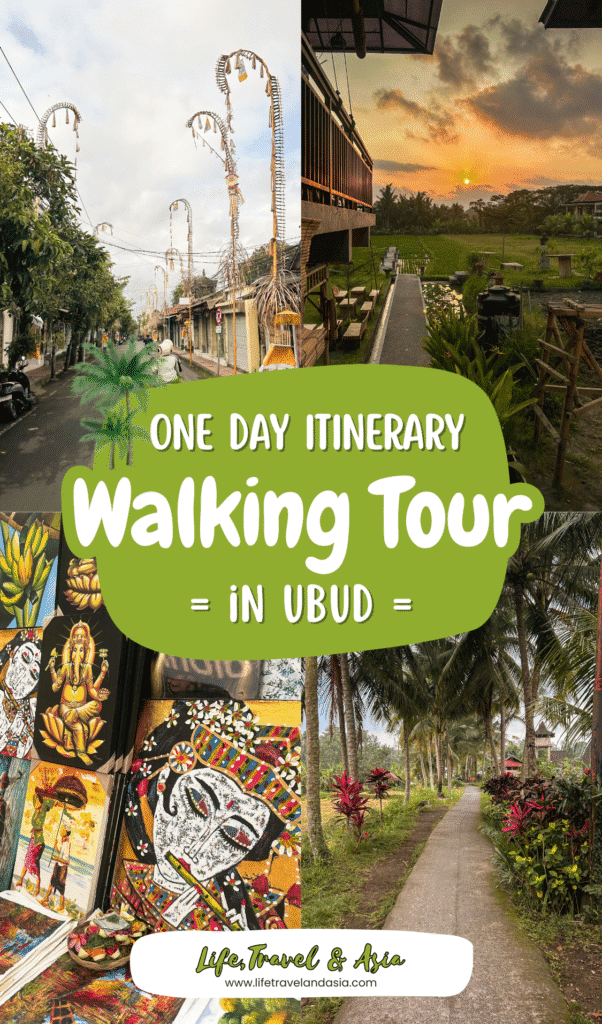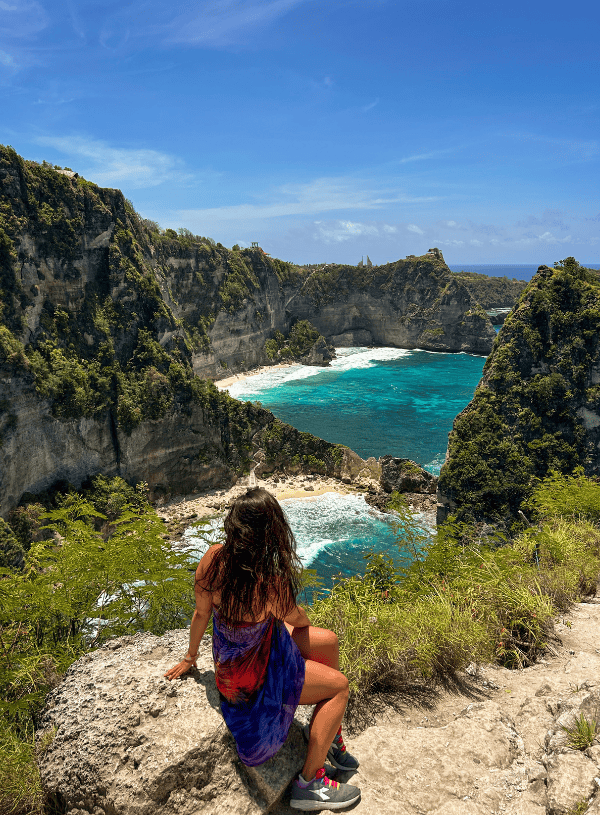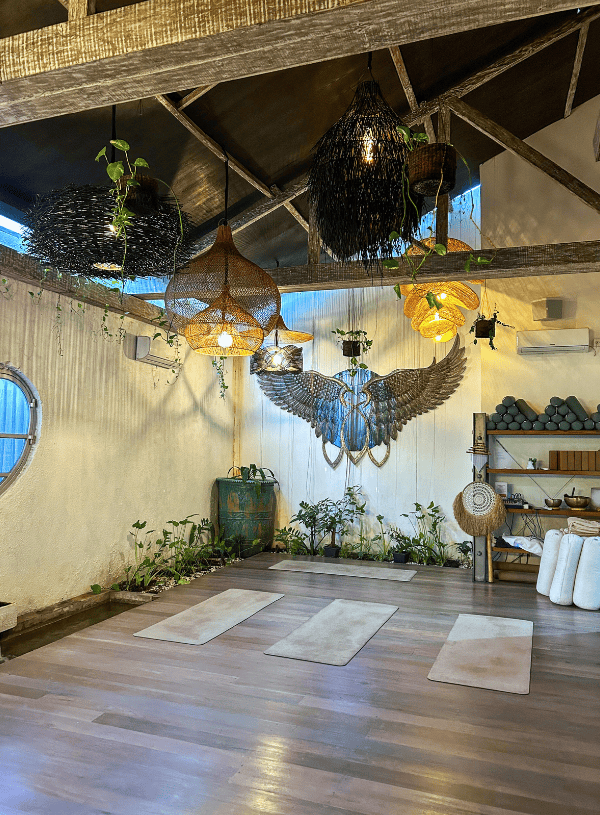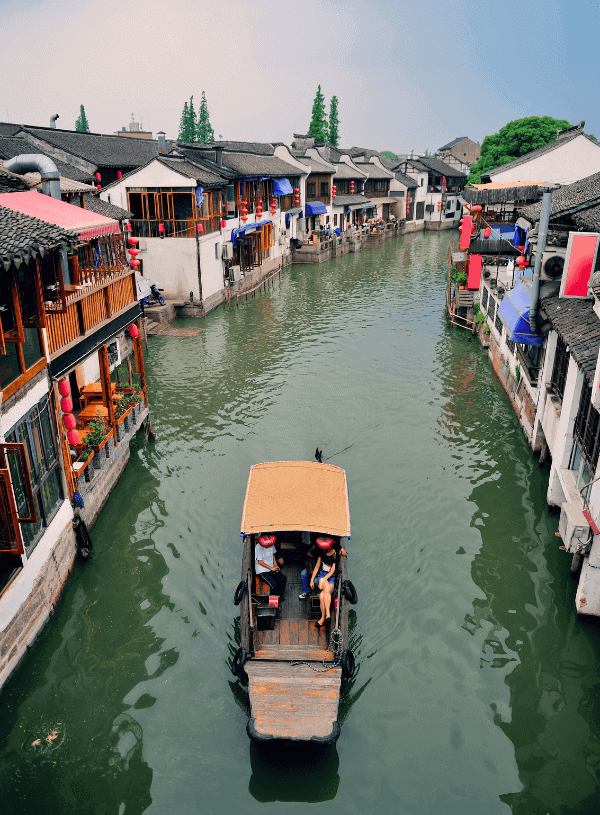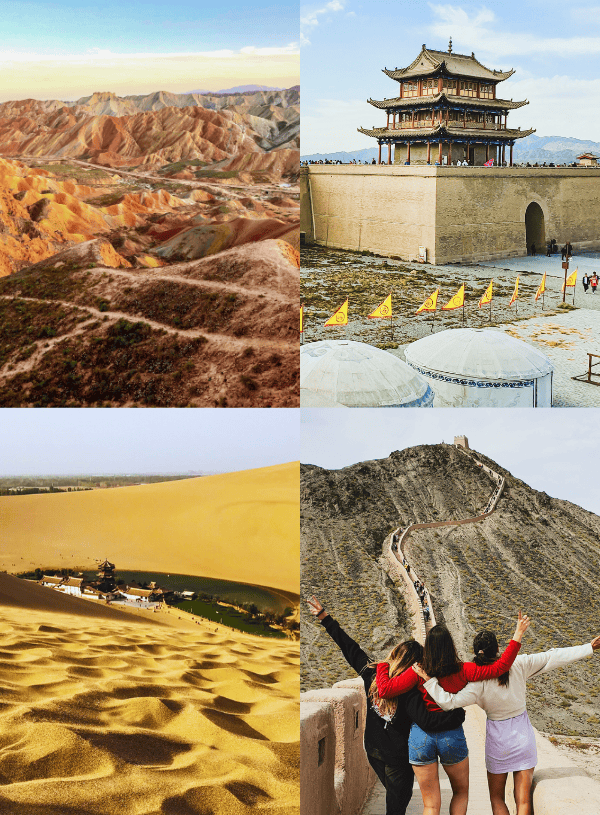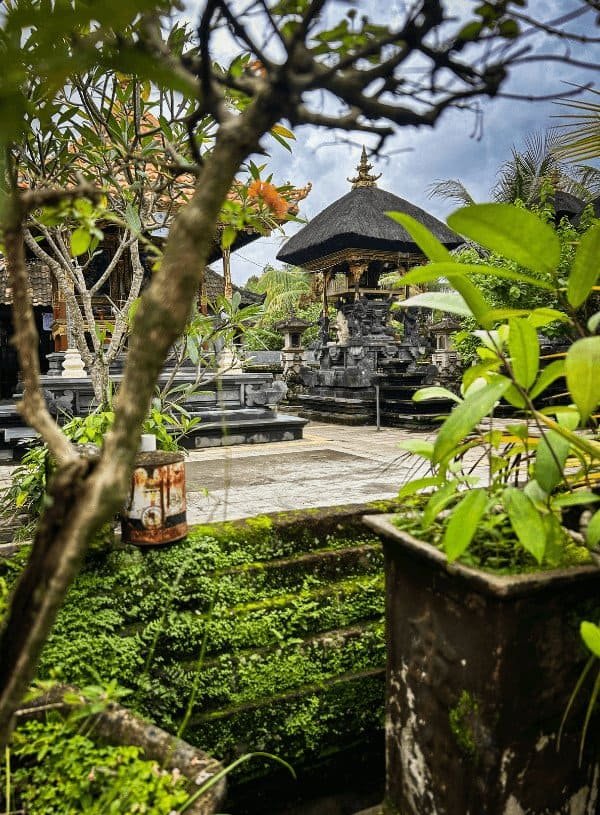Self-Guided Ubud Walking Tour: Markets, Temples, Rice Fields & the Best Walks in Ubud
Last Updated on November 16, 2025
Are you planning a trip to Ubud and looking for the best (and totally free) self-guided Ubud walking tour? You’ve landed in the right place!
I’ve been living in Ubud for a few months now, right in the heart of the town — close to the main sights but far enough from the chaos.
And I’ve learned that the best way to discover Ubud’s true essence is on foot. The town is small, walkable, and full of hidden surprises at every corner — especially if you only have one day to explore.
In this post, I’ll share the best walks in Ubud — routes I take almost every day. You’ll pass temples, local markets, hidden rice fields, and cozy cafés perfect for escaping the heat (or a sudden rain shower). Ready to explore the best of Ubud in a single day? Let’s start walking.
This article may contain affiliate links. This means that if you purchase through one of the links, I may be paid a small commission at no extra cost to you. Thank you for supporting the blog and allowing me to keep sharing meaningful travel experiences with you.
Don’t have time now?📌 Save it for later!
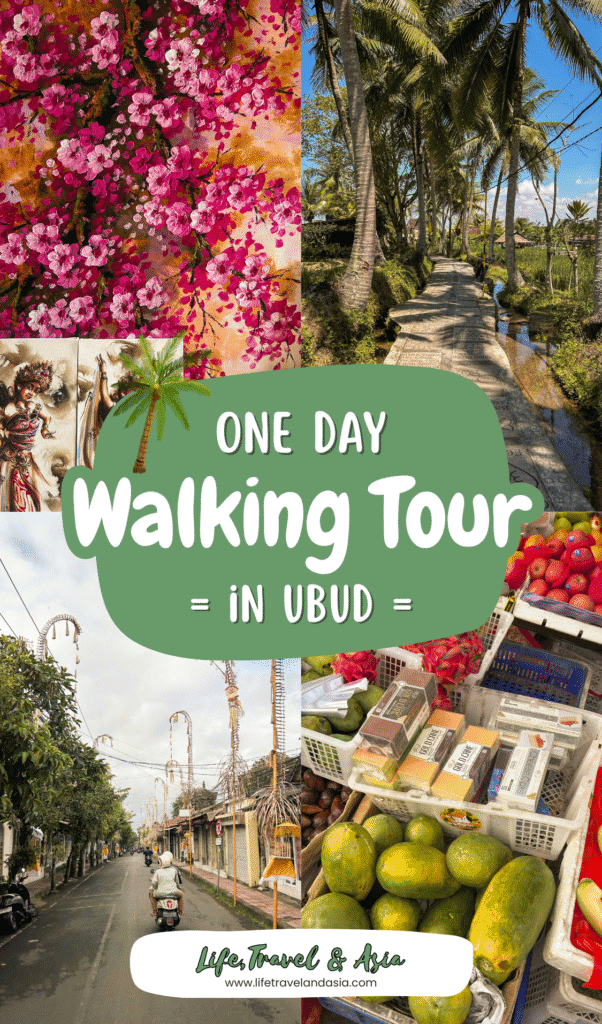
Can You Walk Around Ubud?
Yes, Ubud is very walkable. And by very walkable, I mean that you’ll usually find sidewalks in most places (not everywhere — and the quality is debatable).
There are also many chances to escape the main busy roads and find yourself surrounded by scenic rice field trails and narrow lanes where you won’t find any cars. Worst case, there will be a few scooters zipping by.
That said, I always suggest keeping an eye on where you’re walking (and avoiding too much phone scrolling), because roads in Ubud often have potholes and can be uneven — it’s not uncommon to trip if you’re distracted.
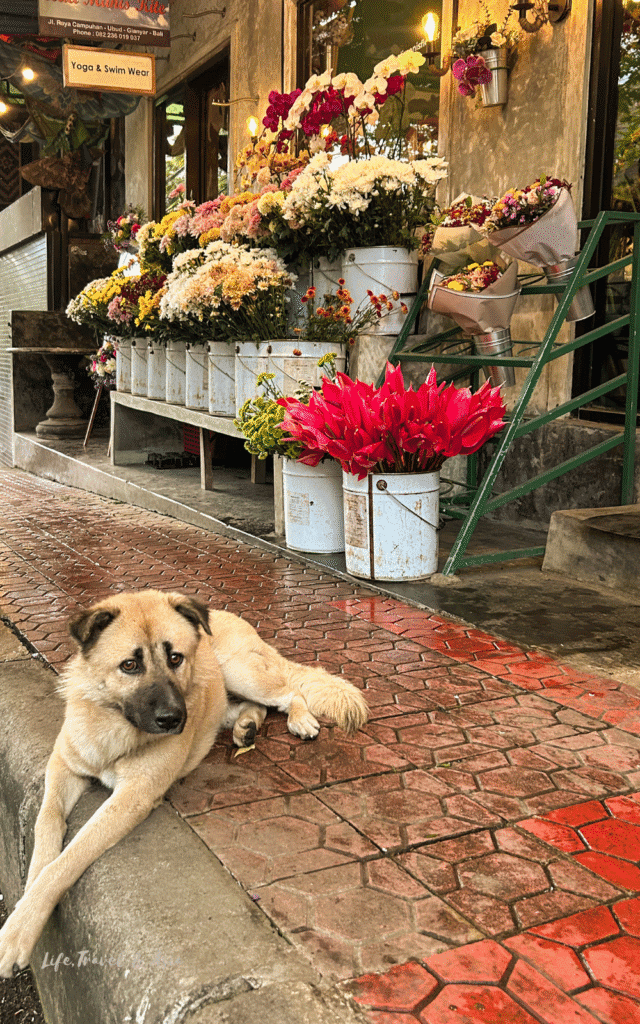
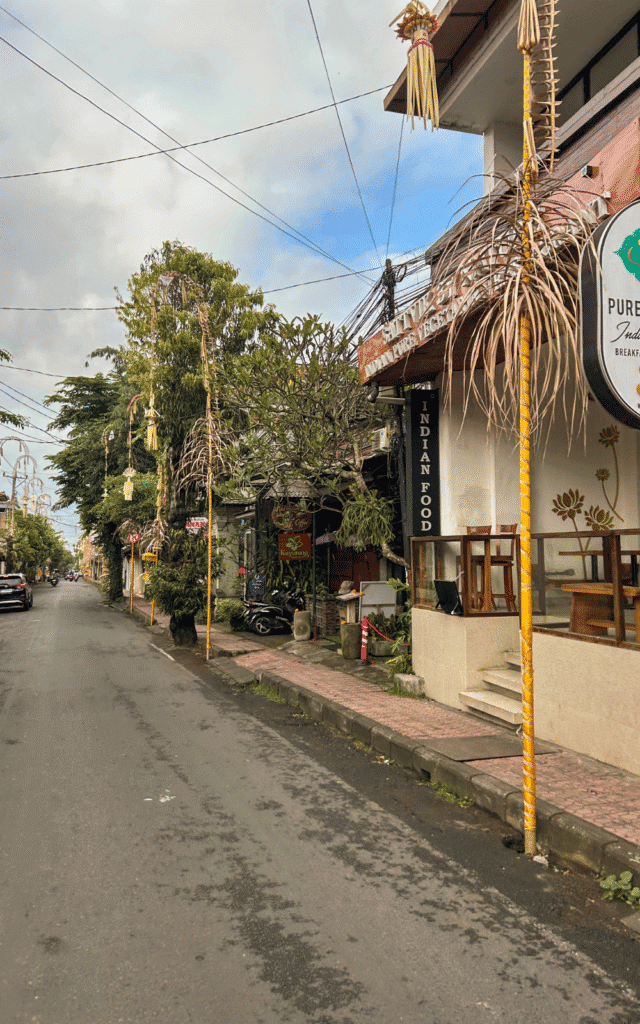
Finally, remember Ubud is on a tropical island, and the heat can be intense at times, especially during the rainy season (which, funnily enough, is also summer — so humidity and temperatures are higher).
For this reason, I recommend planning your Ubud walking tour in the morning and finding spots to stop and refresh along the way.
Where to Stay in Ubud
If it’s your first time in Ubud or you’re only staying for a few days, the best area to stay is close to the center — not right on Jl. Raya Ubud, but nearby. Jl. Bisma is my top pick (especially if you’re planning a walking tour).
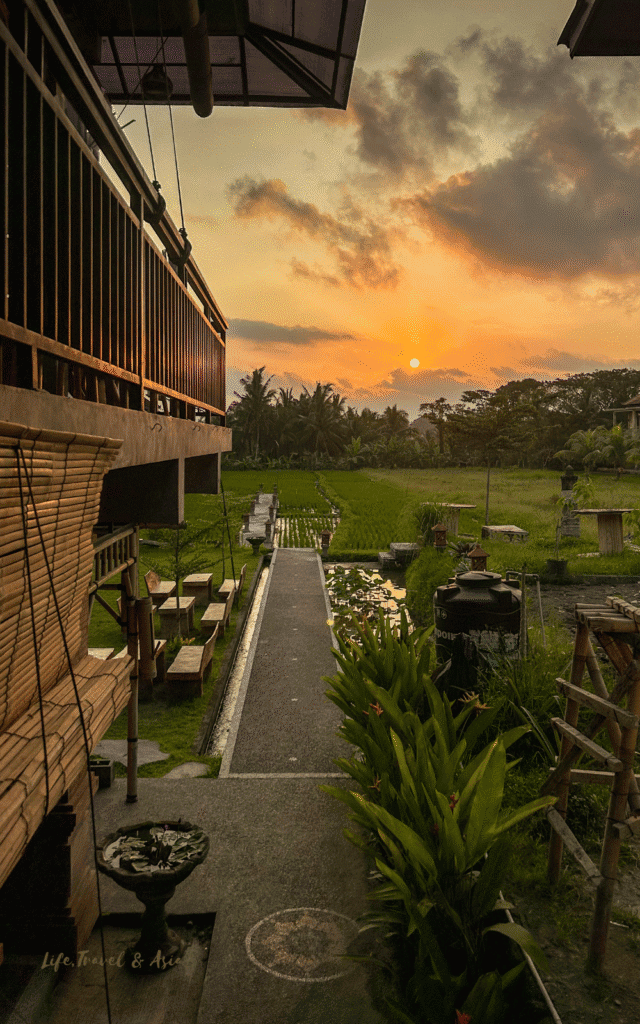
Jl. Bisma is surrounded by rice fields and offers plenty of options — from budget-friendly guesthouses to boutique hotels. You’ll also find lots of restaurants, warungs, cafés, spas, art workshops, and even a padel court.
Jl. Bisma is very close to:
- Ubud Monkey Forest
- Campuhan Ridge Walk & Gunung Lebah Temple
- Pura Dalem Ubud Temple
- Penestanan Village
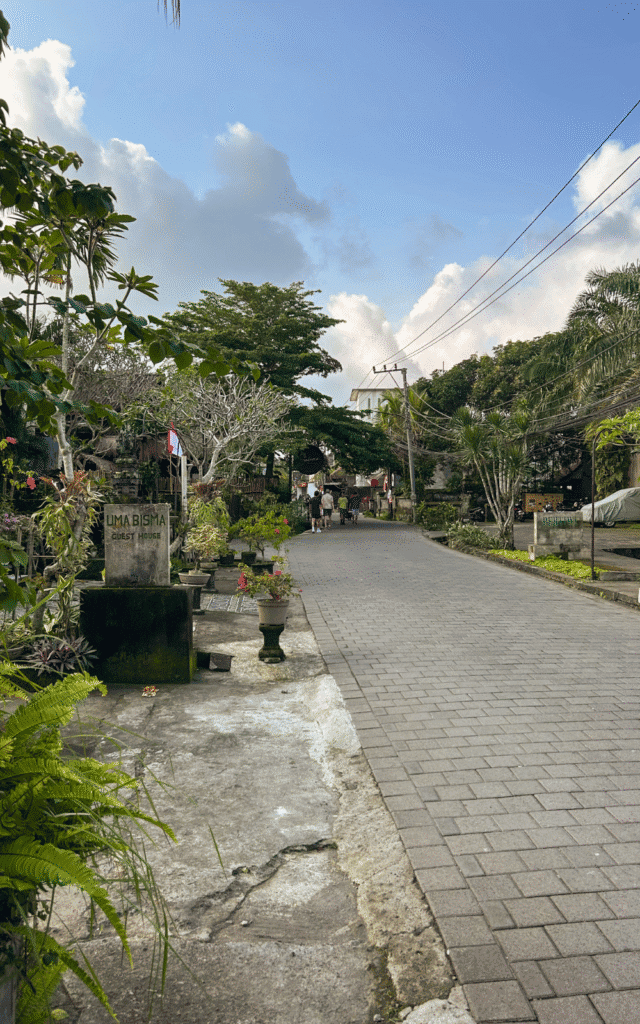
If you’re looking for a place to stay on Jl. Bisma, here are some recommendations:
- Bisma Jaya Bungalow: I’ve been living here for a few months, and it’s the perfect budget-friendly stay. It has a swimming pool surrounded by a beautiful garden, and it’s incredibly peaceful despite being very central.
- Pertiwi Bisma Ubud: Great if you want to be close to nature but still enjoy modern, cozy rooms. The hotel has two swimming pool areas to choose from, and they can help arrange anything from tours to transport.
- Bisma Eight: One of the most iconic boutique hotels in Ubud — you really can’t go wrong here. The hotel is absolutely stunning, with infinity pools offering 360° views of the jungle.
If you’re curious about other areas to stay in Ubud — whether equally central or tucked away among the northern rice fields — have a look at this guide on where to stay in Ubud.
Ubud Walking Tour Map
In this post, I’ll share a few self-guided Ubud walking tours.
After spending quite some time here, I can tell there are so many ways to explore: you can plan to see the Ubud classics in the center, head to quieter corners like the rice fields up in Kedewatan Village, or just let yourself get lost in the narrow alleyways of town, discovering small local shops and warungs along the way.
All the Ubud walks mentioned are on the map below.
1. Ubud Morning Market
From 7 am
The market area in front of the Ubud Palace is usually home to the famous art market — but not at 7 am. Early in the morning, when most tourists are still asleep, the heart of town transforms into a lively, colorful mix of sounds, smells, and energy that instantly wakes you up (if you’re not already).
The vivid colors of dragon fruit, papayas, and limes; the scent of fresh spices, herbs, and frangipani flowers; and the cheerful voices of locals chatting with customers or among themselves all fill the air.
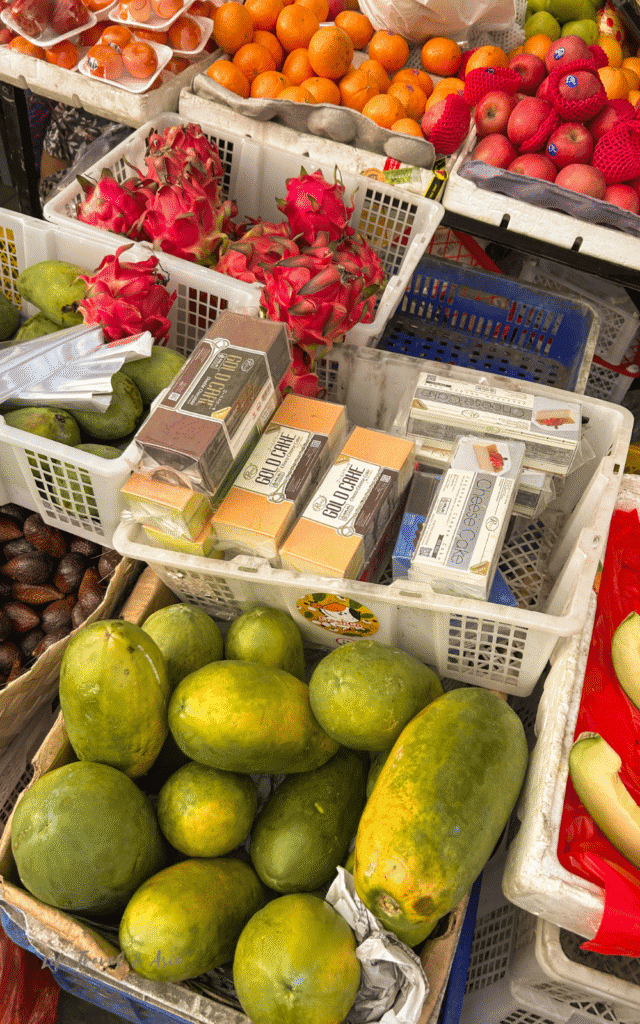
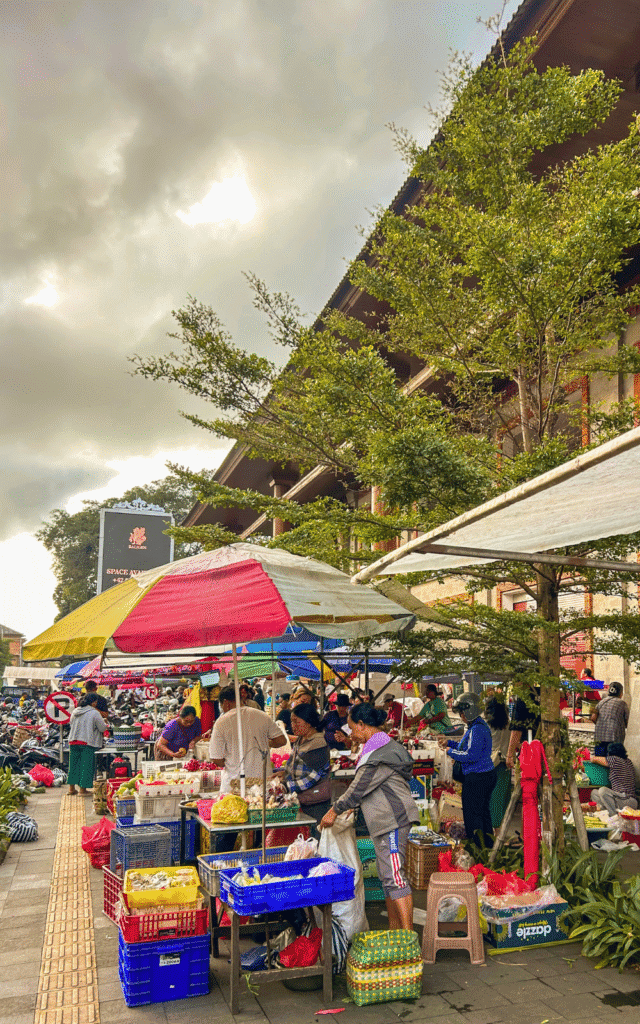
That’s the morning market — and it’s a wonderful way to start your day, getting a glimpse of authentic local life.
You can wander through the small stalls lined up side by side, pick up special spices or herbs, or find yourself enchanted by the bright flowers used to make the canang sari offerings.
2. Breakfast or Coffee At Clear Café
Clear Café is one of the cutest cafés in Ubud. Its design is really unique — it reminds me of a Japanese garden, with a koi fish pond, ground seating, and flowing fountains. It’s a lovely place to stop by, just about a 7-minute walk from the morning market.
If I had to suggest something, I’d go for one of their smoothie bowls — true works of art — but honestly, you can’t really go wrong here. One of their core values is to use the highest-quality ingredients, so everything you order is healthy, fresh, and beautifully presented.
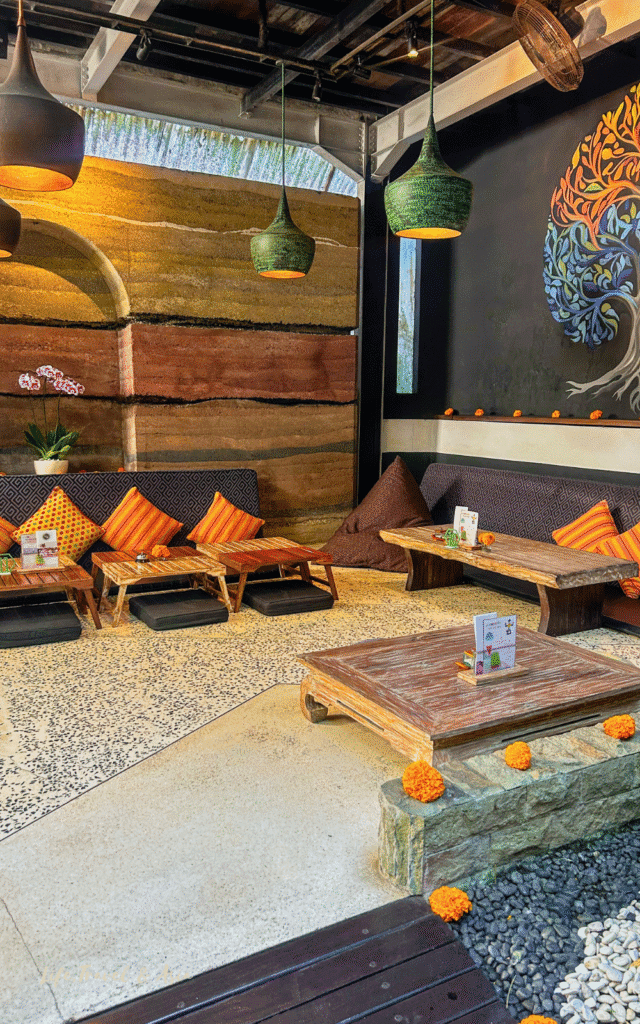
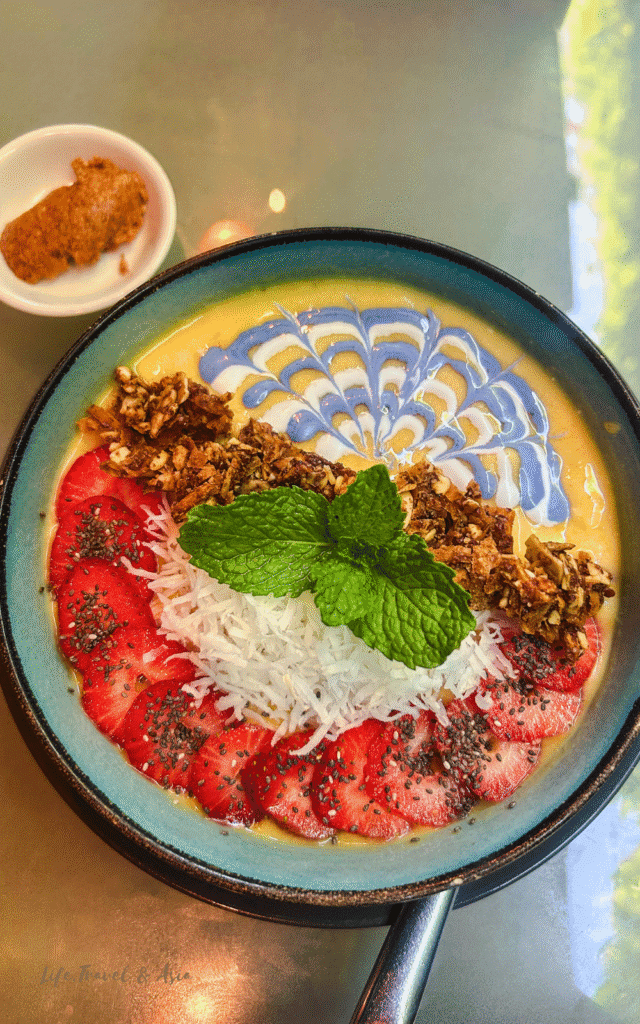
3. Ubud’s Palace
From 7:45–8 am
The Ubud Palace is one of the few tourist spots that opens very early. I first visited around 7:45 am, and honestly, that’s the best time to be there.
The two small inner courtyards are beautifully detailed with intricate carvings, red sandstone gates, and traditional pavilions decorated in gold.
Everything is so carefully maintained — from the gardens and trees to the statues and architecture. You can immediately tell this is the heart of town and one of Ubud’s most important landmarks.
It’s a small site, and the space fills up quickly, so I definitely recommend going early in the morning.
That way, you’ll have time and room to take photos and appreciate every little detail. Entrance is entirely free, there’s no specific dress code, and you’ll only need about 30 minutes to visit.
4. Saraswati Temple (Ubud Water Palace)
From 8 am
Right across the road from the Ubud Palace, you’ll find the Saraswati Temple. The name can be a little misleading, though — the temple itself isn’t open to tourists, but visitors can explore the outer garden, which is absolutely beautiful on its own.
The ticket costs IDR 60K ($4), and at the entrance, you’ll be asked to wear a vest and a sarong. (With your ticket, you’ll also get a 10% discount at Lotus Café, which is attached to the temple.)
The Saraswati Temple garden is unique and full of details: a dreamy lotus pond crossed by a small bridge, fountain statues lining the path, and the three tall red sandstone gates standing majestically in the background.
Most of the statues are “dressed” in white, purple, and red fabrics, creating a mix of colors that practically begs to be photographed.
The temple can get quite crowded, and since it’s small, people tend not to spread out.
That’s why I recommend visiting right at opening time — it’s the best way to take in its atmosphere, colors, and details in peace.
5. Sweet Orange Trail & Kajeng Rice Field Walk
Just five minutes from the busy main road, you can find yourself surrounded by beautiful rice fields. To get there, you have two options.
The first option is to go back a few meters from Saraswati Temple and look for the sign Subak Juwuk Manis Walk.
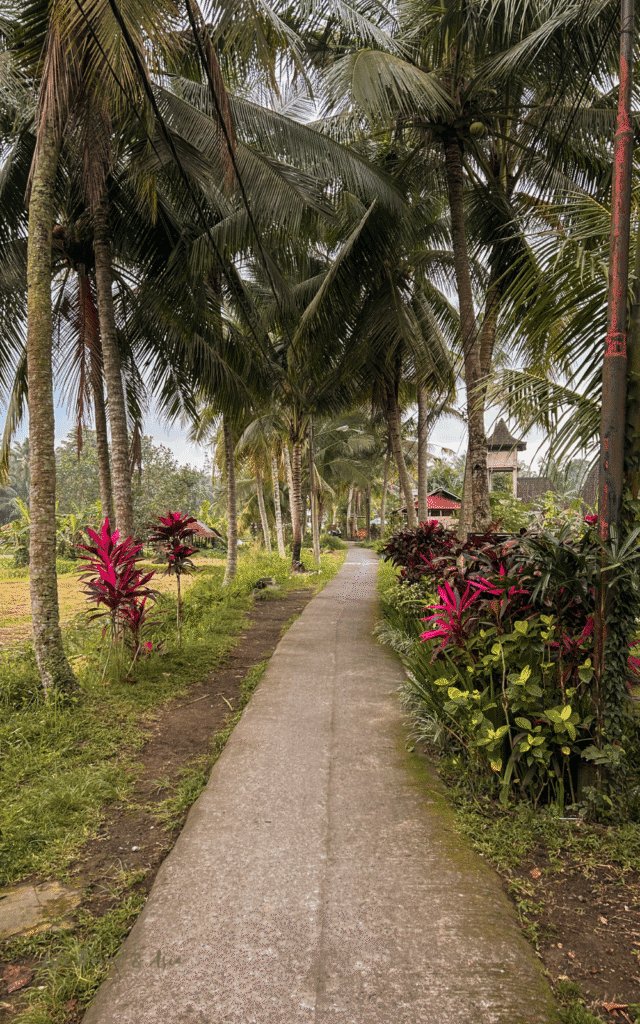
The path starts a bit rough and adventurous, but soon leads you to the Sweet Orange Trail — a narrow paved path lined with towering palm trees and surrounded by vivid green rice paddies.
You’ll know you’re in the right spot when you reach the Sweet Orange Warung, which gives the trail its name.
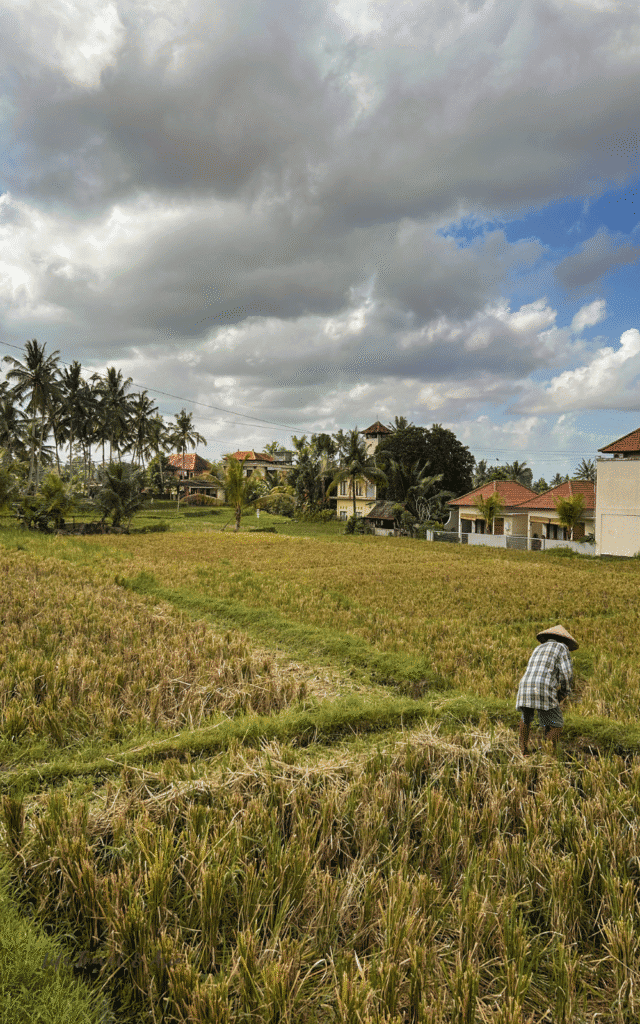
The second option is to turn left from the Saraswati Temple, cross the Jl. Kajen Art Market (which opens around 10 am), and follow the narrow alley past Ubud Sari Health Resort until you see the Subak Juwuk Manis Walk sign.
Either way, you’ll end up in a vibrant sea of green and swaying palms.
You can continue all the way to the end of the trail, or once you reach the Sweet Orange Warung, cross to the other side — the two trails are connected, making it easy to explore both.
6. Jl. Kajeng Art Market Or Massage at Ubud Sari Health Resort
From 10 am
While you’re here, take some time to browse the smaller — but still lovely — art market on Jl. Kajeng, and don’t miss the messages left by visitors carved into the tiles along the walkway.
The name “art market” can be a bit misleading, because you’ll find all kinds of souvenirs: printed clothes, magnets, Bali-branded bags, wooden bowls, and home decorations.
At the right end of the street, there are more upscale shops selling jewelry, handbags, clothes, and a couple of affordable warungs.
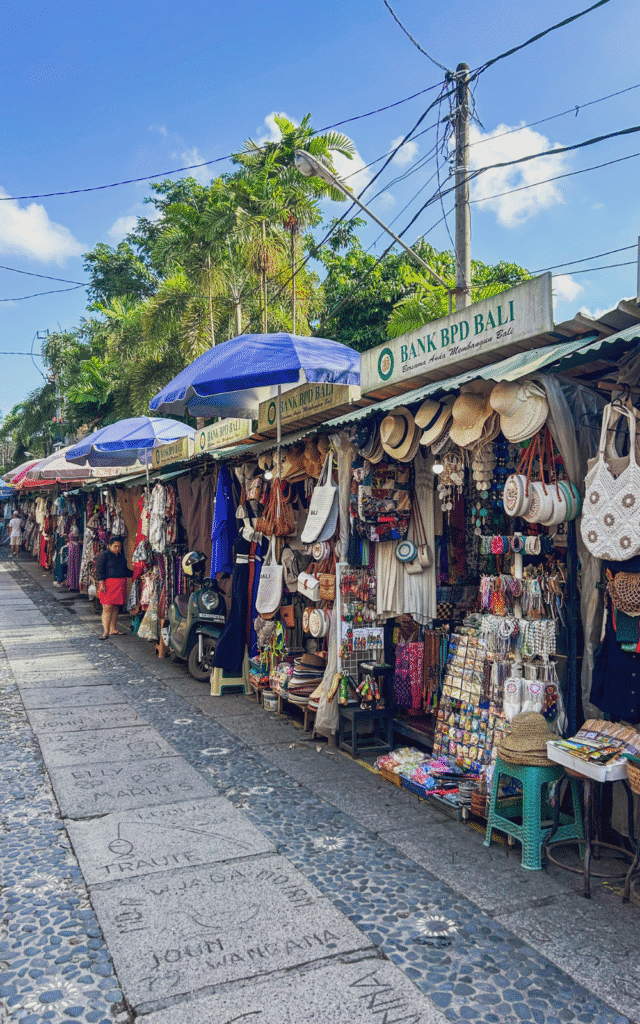
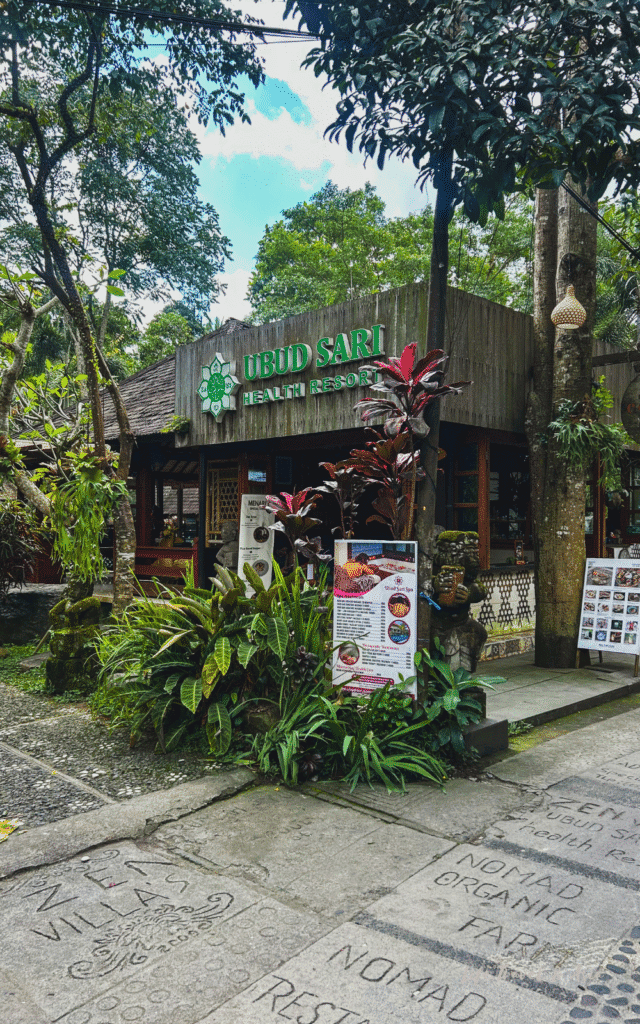
If shopping isn’t your thing or you’re only in Ubud for a short time, consider booking a massage at Ubud Sari Health Resort, just at the end of the road.
Their signature massage costs only IDR 250,000 ($15), and I can definitely recommend it — the massage itself is excellent value, the resort is tucked away in a beautiful garden with pavilions surrounded by nature, and the staff is very welcoming and kind.
7. Lunch at Sweet Orange Warung or Compound Warung
Right in the city center of Ubud, there are two of my favorite warungs: Sweet Orange Warung and Compound Warung.
Sweet Orange Warung is, as mentioned before, on the Sweet Orange Trail. It’s the perfect spot for lunch if you want to enjoy the rice field views a bit more.
The place is lively and usually packed at lunchtime. Here you can find the best of Indonesian specialties, but there are also some Western options if you’re a picky eater.
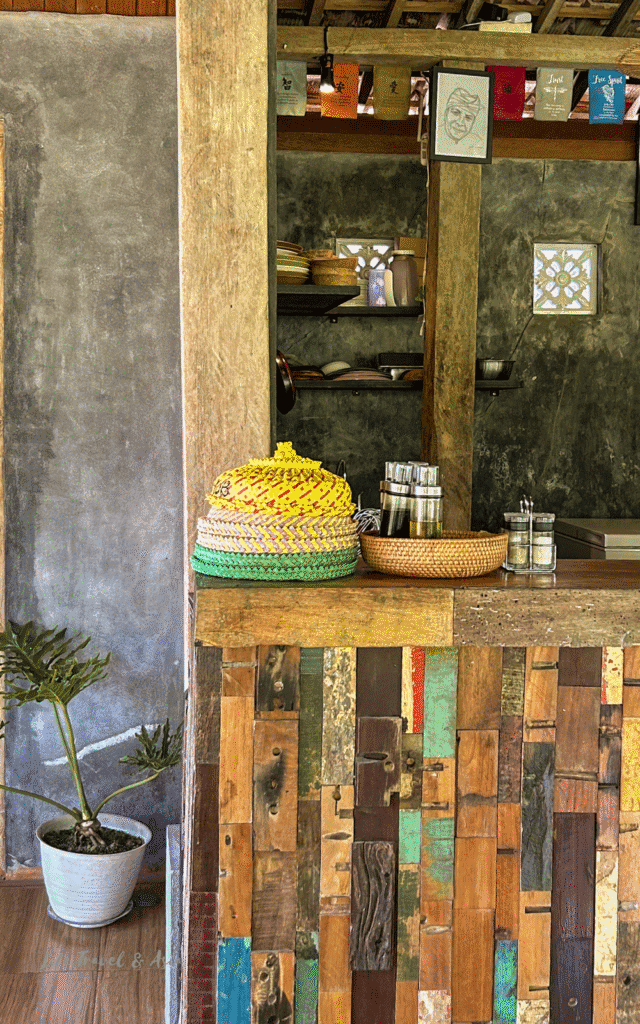
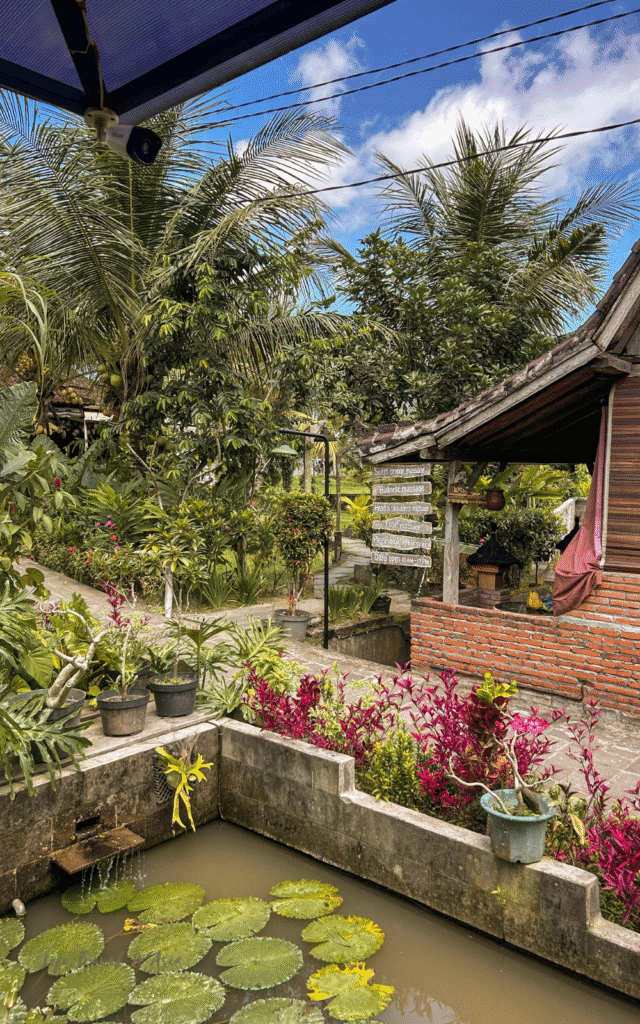
Compound Warung is about a 10-minute walk from the Jl. Kajeng Market, on Jl. Goutama. While it’s usually busy at dinner, lunchtime is incredibly calm.
Here you’ll find some of the best — and I really mean the best — Indonesian food in town. It’s also one of the most affordable warungs among the already budget-friendly options.
8. Art Market
It’s time to head back to the market area, because by now the art market has taken over the morning vegetable stalls.
If you didn’t find what you were looking for at Jl. Kajeng Market, you might have better luck here.
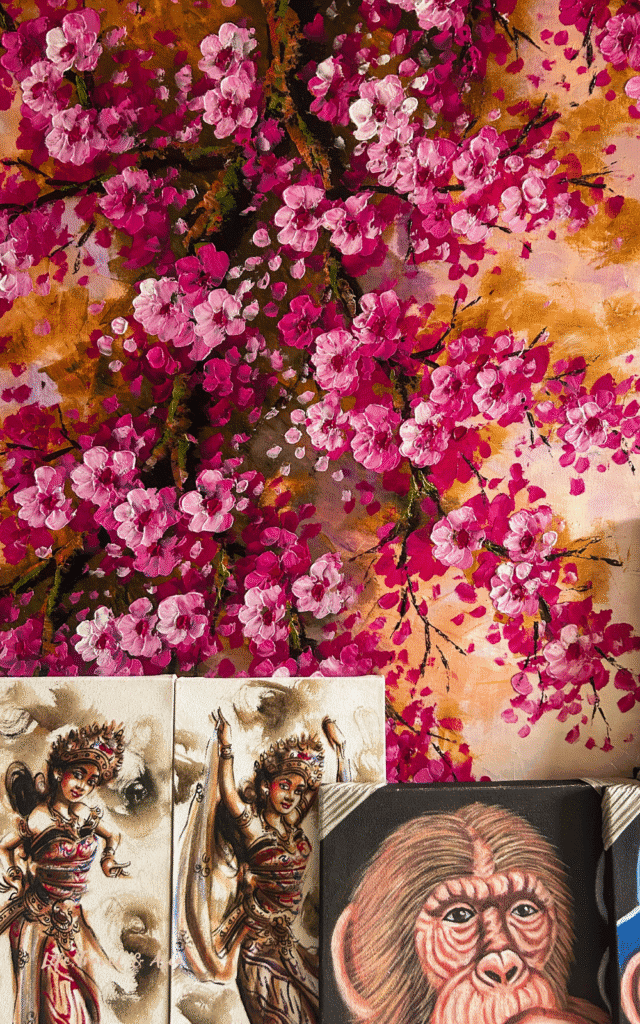
Don’t forget to bargain with the sellers — and don’t be shy to ask for the “Bali price.” You’ll find pretty much everything you could need.
On the top floor, you’ll find artists selling their paintings, but the real focus is on quirky finds: souvenirs, wooden crafts, bags, accessories, and sarongs. You name it.
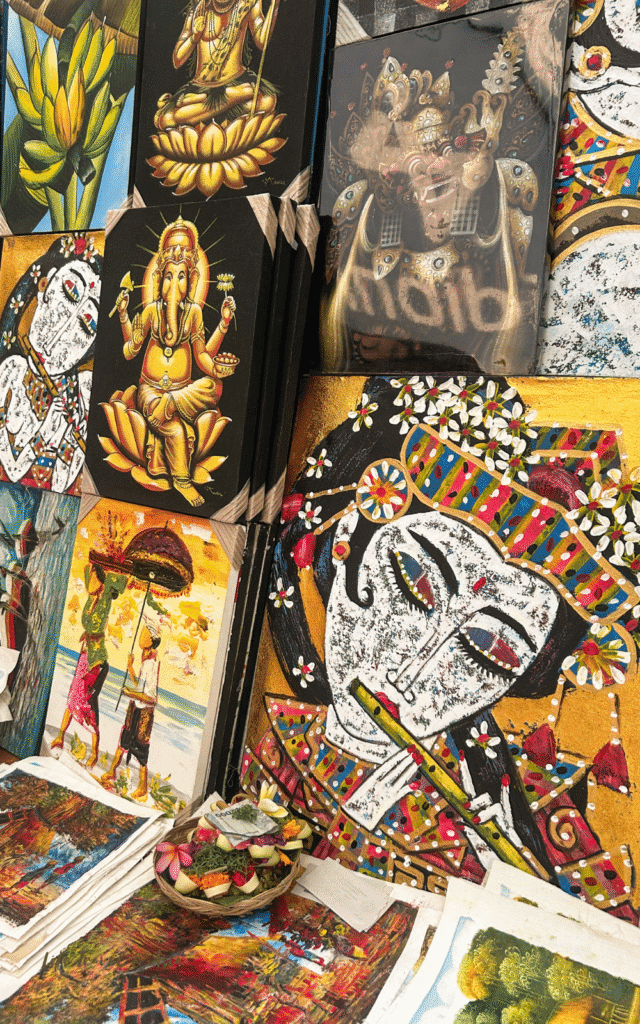
9. Pura Dalem Ubud
From the art market, it’s time to head back to the end of Jl. Raya, toward Jl. Bisma (6-minute walking distance).
For some reason, Pura Dalem Ubud isn’t included in most walking tours. Still, it’s impossible to pass by without stopping in front of its majestic stairs and candi bentar gate, wondering what secrets lie among the tall, hanging trees visible from outside.
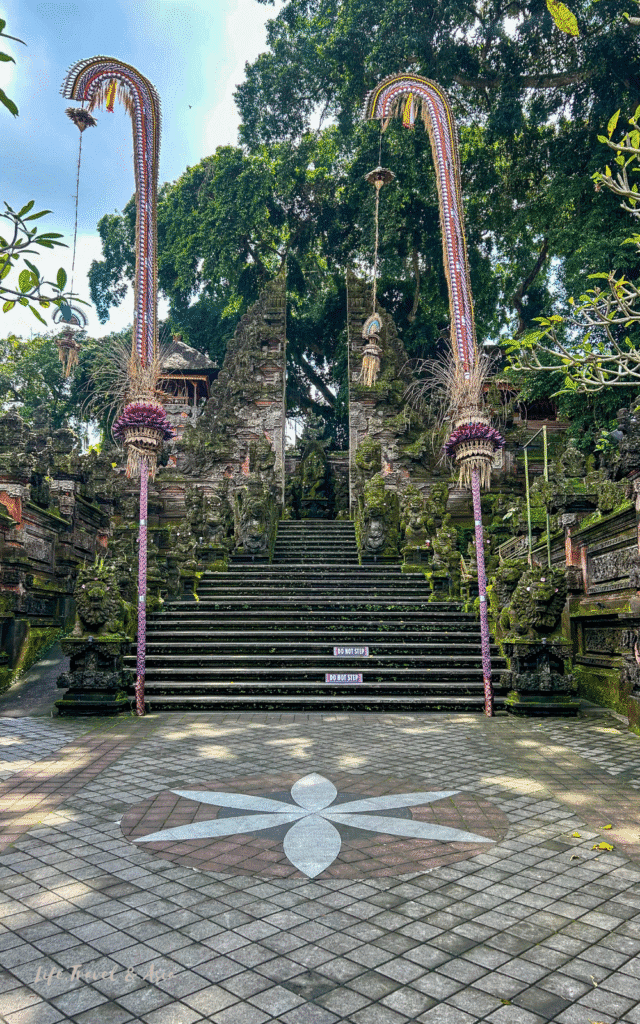
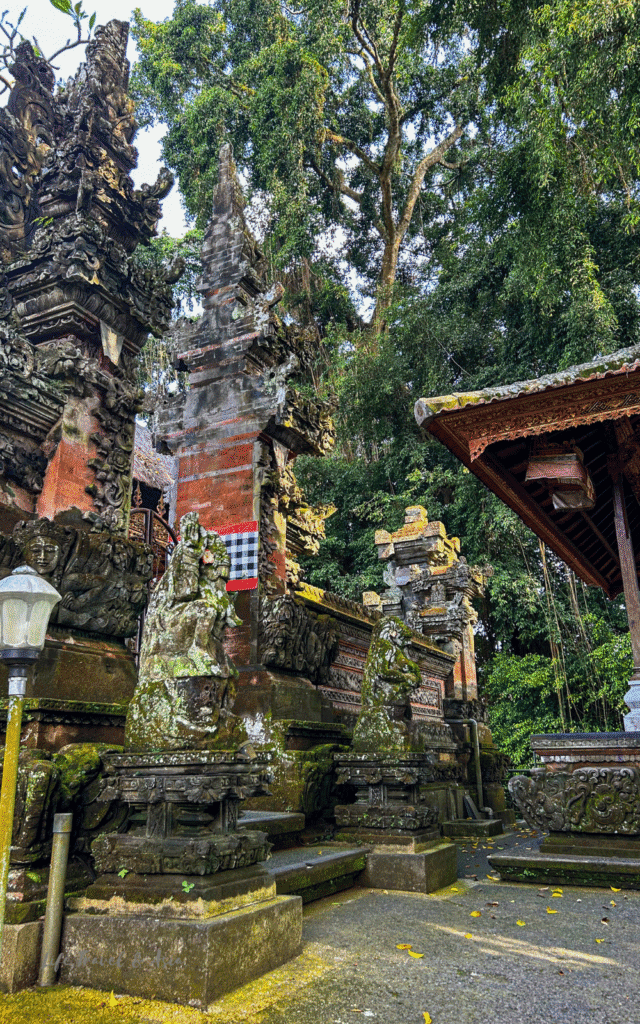
The temple is dedicated to Rangda, the demon queen, and you’ll find statues of demons scattered throughout the complex — probably one of the reasons it feels a little intimidating at first.
Once inside, it’s incredibly peaceful and calm, and you’ll rarely find another visitor around, making it the perfect temple to explore in the afternoon.
Keep in mind that Pura Dalem isn’t always open, as it often hosts ceremonies that restrict visitor access. When it is open, the hours are 10 am to 5 pm, and the entrance fee is IDR 25K, which includes a sarong.
10. Pura Gunung Lebah
After Pura Dalem, it’s time to take the sidewalk down toward Penestanan, passing along that road I love so much, lined with hanging trees that almost block the view of the sky.
As you walk down, turn left at Ibah Villas, and you’ll find yourself in one of the most magical and spiritual places in Ubud: the Campuhan River Valley.
Here, the two rivers, Tukad Wos Lanang and Tukad Wos Wadon, meet — a place of convergence that once drew the Indian priest Rsi Markandeya. Guided by the divine, he founded a meditation sanctuary here, which later evolved into the Pura Gunung Lebah temple.
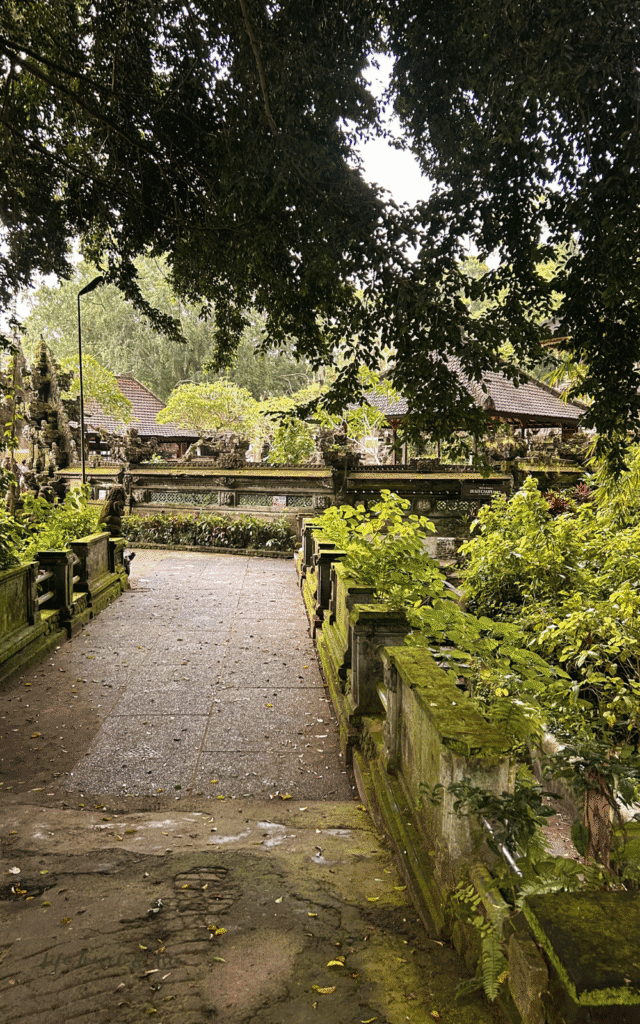
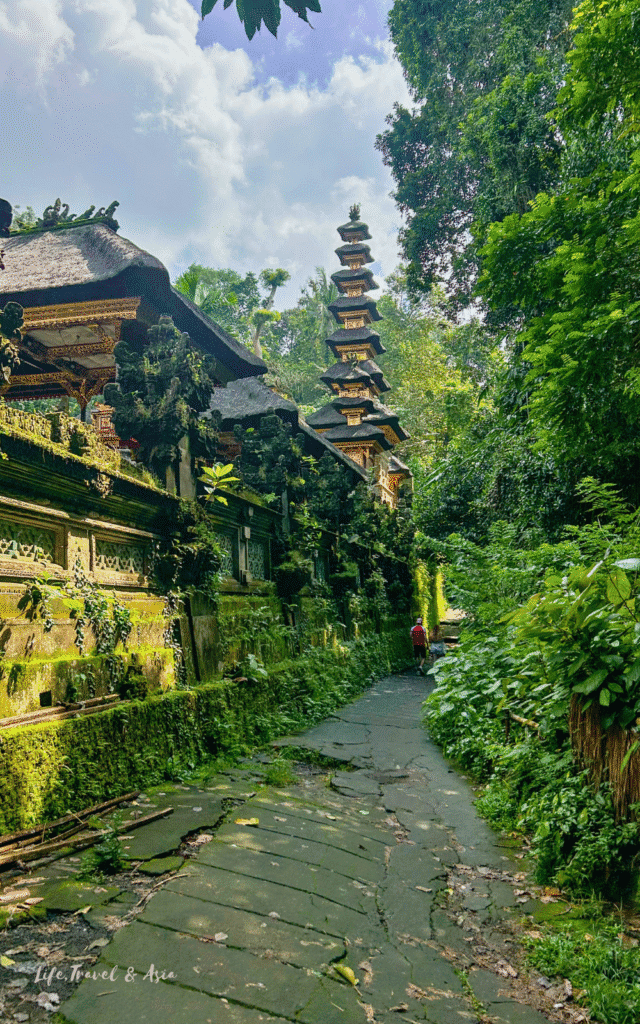
This is probably my favorite place in Ubud. As you arrive, you hear the sound of water flowing below, and the valley is completely enveloped in towering trees and nature. In front of you, the beautiful temple stands strikingly, with its meru shrine peeking out from behind.
The temple is usually closed to visitors, opening only for full moon ceremonies. But even just seeing it from the outside is absolutely worth it.
11. Campuhan Ridge Walk
On the right of Pura Gunung Lebah, you’ll find the start of the Campuhan Ridge Walk.
If you have some energy left, consider climbing the stairs at least until the viewpoint, where the trail opens up to stunning views of the jungle surrounding Ubud.
It’s actually a great place to enjoy the sunset and witness the sky turning pink and orange hues (if on a clear day).
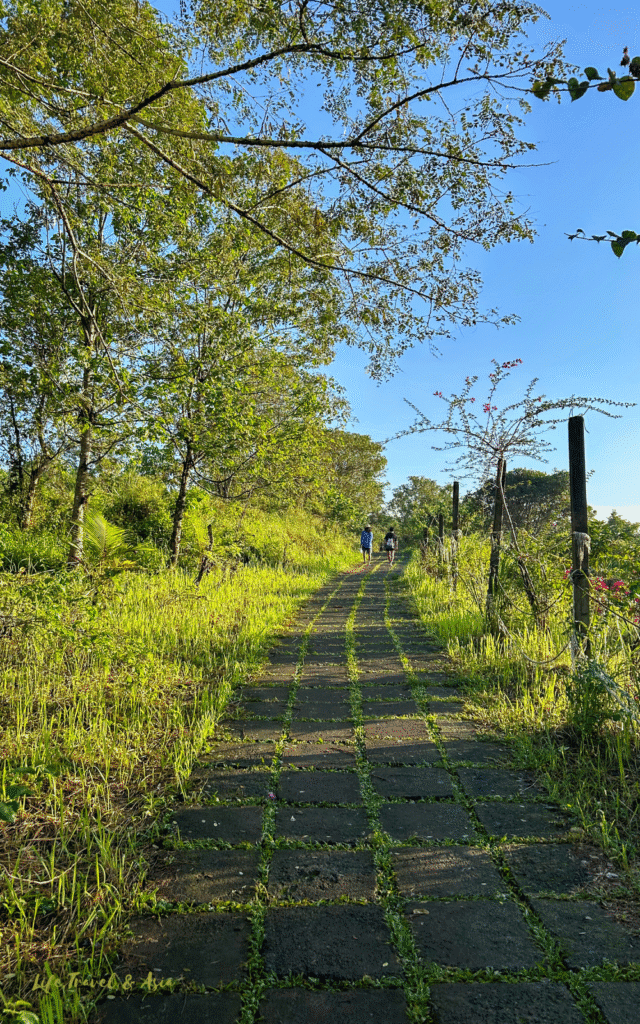
Compared to the rice field walks, this one is a bit more challenging. It’s not a rice terrace trail, but a path winding along a ridge, with lush Ubud jungle on both sides.
The trail goes up and down until you reach a small village at the end, which is worth exploring.
To complete the walk and reach the village, it will take around 30 minutes. Once there, you can grab a fresh coconut or browse some of the small art galleries before heading back down.
12. Zest
From the Campuhan Ridge Walk and Pura Gunung Lebah, it’s just a 12-minute walk (with a very short uphill section) to one of the most popular vegan restaurants in Ubud: Zest.
Even if you’re only stopping for a snack, a coffee, or a short rest after your walking tour, visiting Zest is an experience in itself.
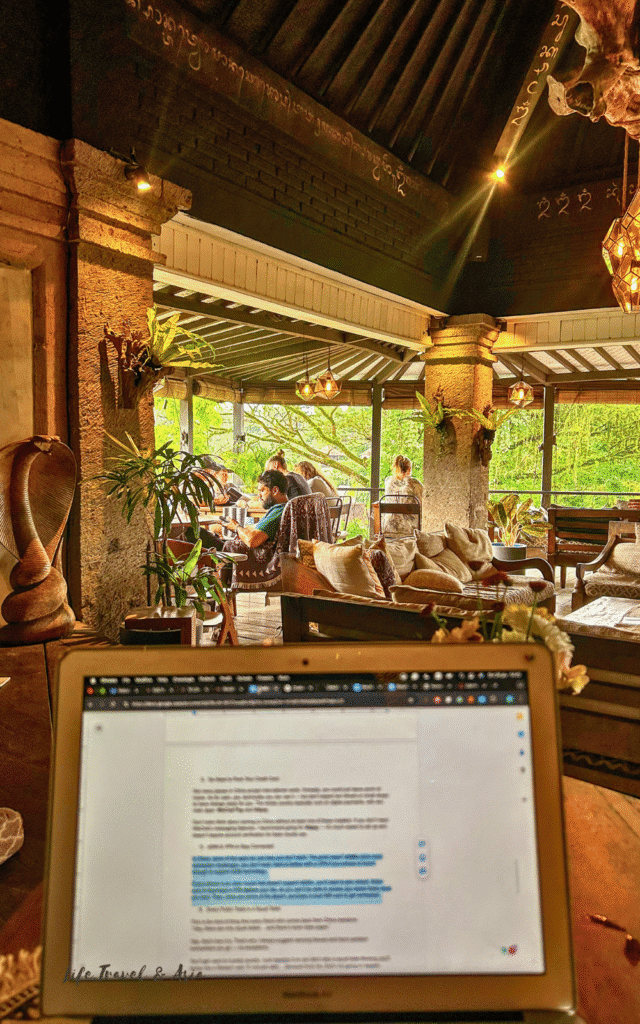
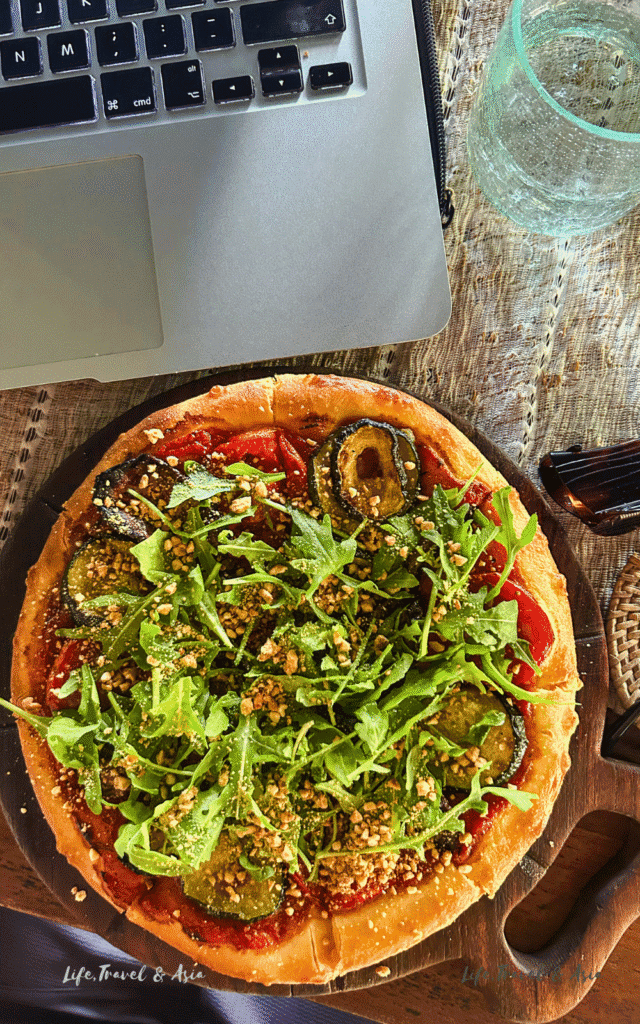
The atmosphere is very chill and hippie, with small tables, sofas overlooking the jungle, and low-seated areas.
There’s often music in the background, sometimes with local artists jamming, making it the perfect place to relax.
Everything on the menu is 100% vegan (they don’t even offer regular milk) and absolutely delicious — sometimes light, but always worth trying.
Other Ubud Walking Tours
In addition to the Ubud walking tour above, I also enjoy exploring a few other areas on foot.
These can be great, shorter walks: a morning hot girl walk or exploration to fill an afternoon or a late evening, without having to walk for kilometers.
1. Jalan Subak Sok Wayah walk (Sari Organic Walk)
One of my go-to places for my morning walks, this trail is just perfect for getting some movement in while escaping the traffic and noise of Ubud’s main roads.
It’s a beautiful path surrounded by lush rice paddies, but not only that — along the way you’ll find art workshops (like silver-smithing studios), small art galleries, yoga and meditation retreat centers, and of course, plenty of cafés.
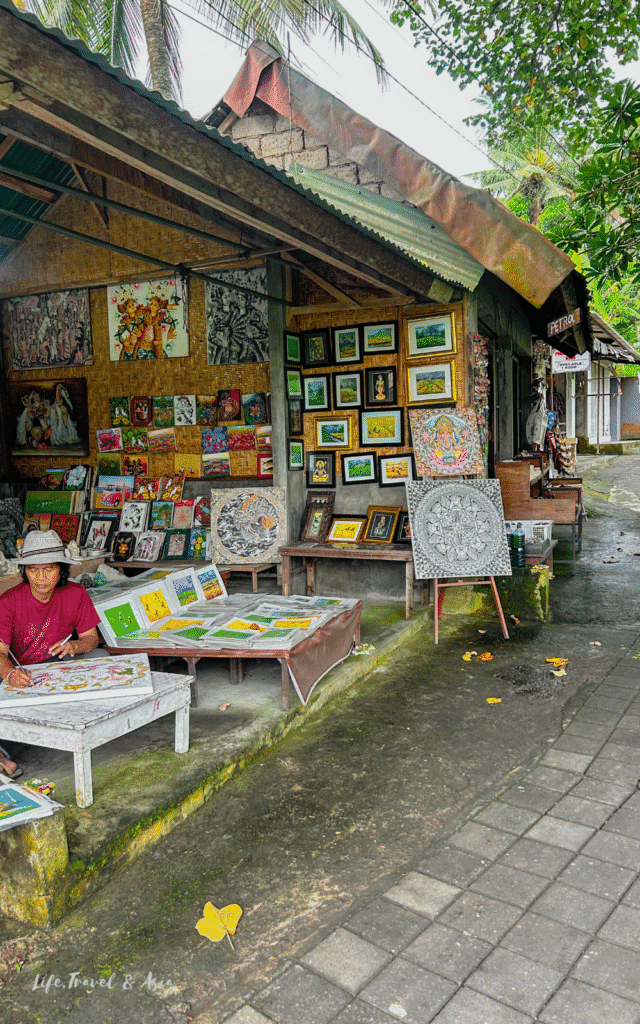
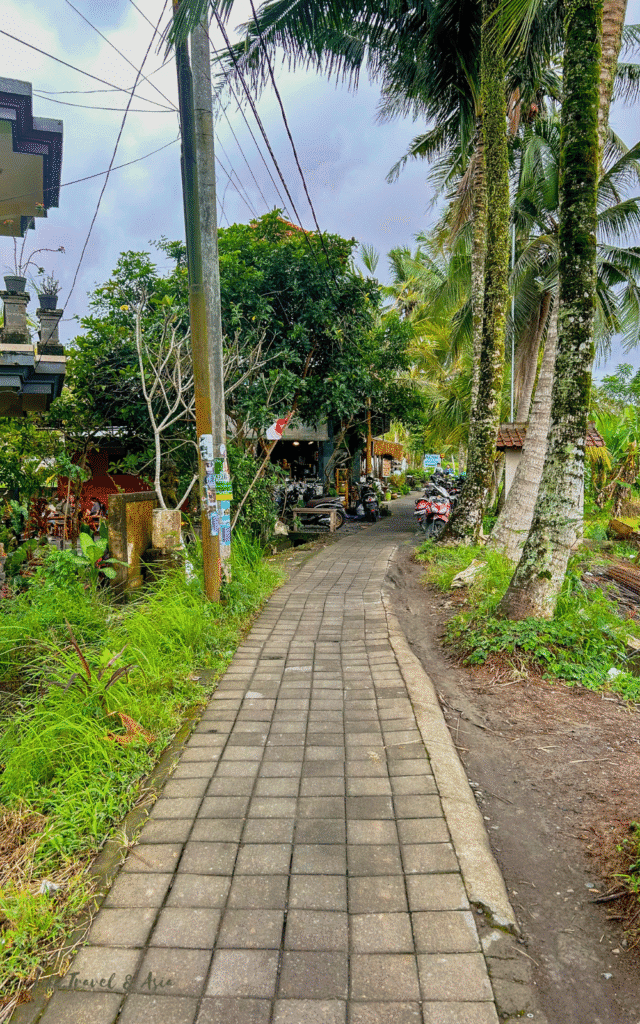
If you’re looking for great breakfast spots in Ubud, this walk is ideal: many cafés here come with serene rice field views (my favorite is Pukako Panini and Coffee).
The trail is quite long, but you can turn back at any time — it’s lovely even if you walk part of it.
To get there, it’s actually very close to Jl. Bisma. At the end of it, turn left onto the main road, pass Pura Dalem Ubud, and after a short walk, you’ll see a small alley on your right going uphill — that’s the entrance. Just follow the signs for Jalan Subak Sok Wayah Walk.
2. From Jl. Bisma to Jl. Hanoman
Right at the end of Jl. Bisma, you’ll find yourself walking down a small alley surrounded by trees, crossing a little bridge, and ending up on Monkey Forest Road.
If you turn right, you might already spot a few monkeys wandering around the trees at the edge of the Monkey Forest.
The entrance to the forest is just a short walk from there. If you’d rather skip the forest, you can continue straight until Jl. Hanoman.
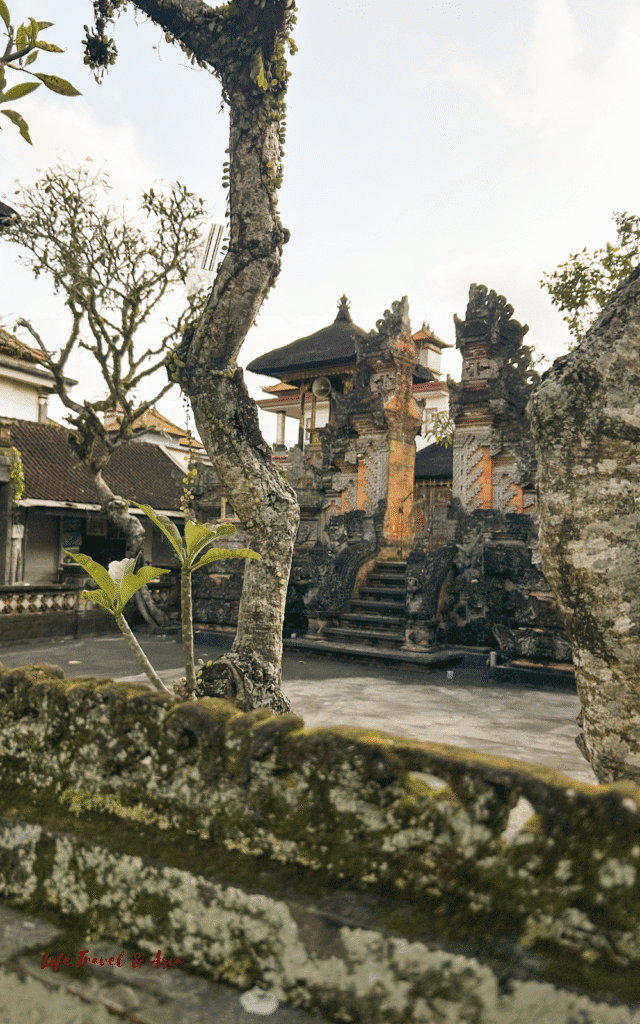
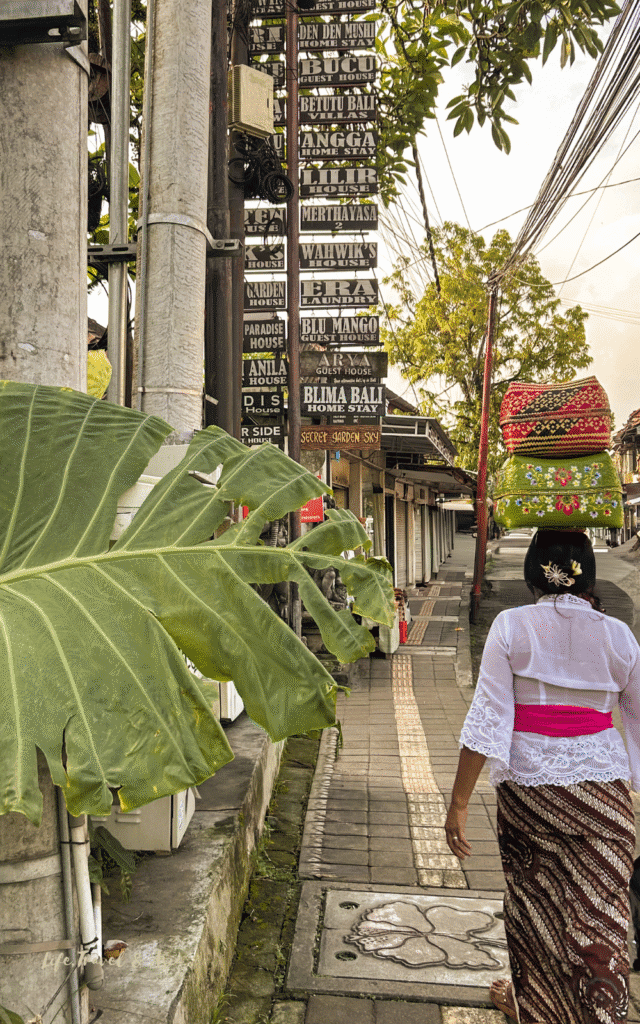
All the way to Jl. Hanoman, the road is lined with restaurants, cafés, and spas — it’s one of the most popular areas in Ubud. I love walking down Jl. Hanoman, because there are so many small temples along the way.
None of them are open to visitors, but walking past them, glimpsing at the traditional courtyards from outside, it’s already worth it.
If you happen to walk here on a ceremony day, you’ll be greeted by colorful decorations, locals wearing traditional attire, and a wonderfully festive atmosphere. Just note that Jl. Hanoman is sometimes closed for these events.
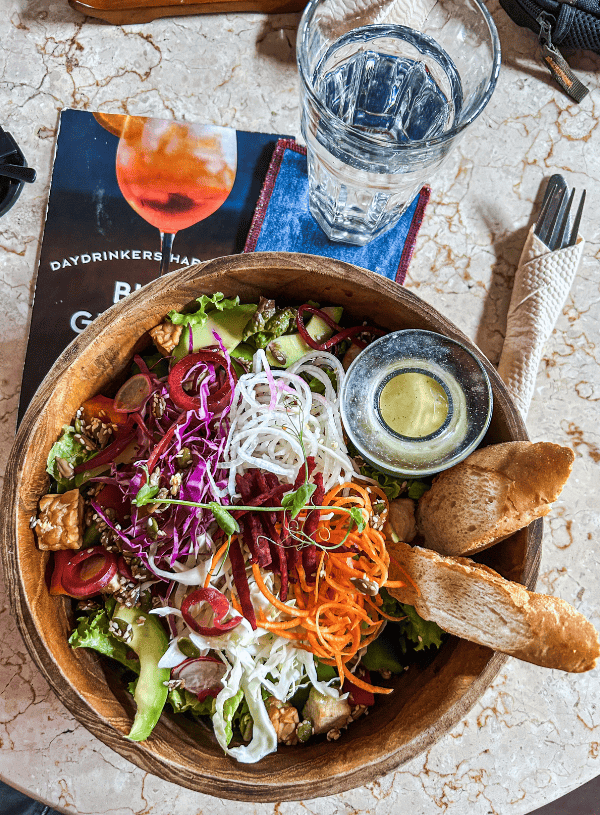
Stop at KAFE if you feel hungry: it’s honestly one of my favorite places to enjoy a hearty, healthy meal or get some work done. (Their Chai Tea is chef’s kiss!)
If you keep walking all the way to the end, you’ll eventually find yourself back on the main street — right by the Ubud Art Market.
3. Jl Goutama & Surroundings
I love walking down Jl. Goutama, especially in the evenings. It’s one of those feel-good walks — surrounded by warungs and restaurants starting to fill up, and quirky little shops selling crystals, holistic products, and special scents.
But I wouldn’t stop there. Around Jl. Goutama — the most popular of these tiny alleys, where only scooters zip by — there are plenty of other lanes worth exploring.
It’s so beautiful to get lost among them, witness local life unfolding, stumble upon a hidden warung no one knows about, or admire the characteristic Balinese-style home compounds.
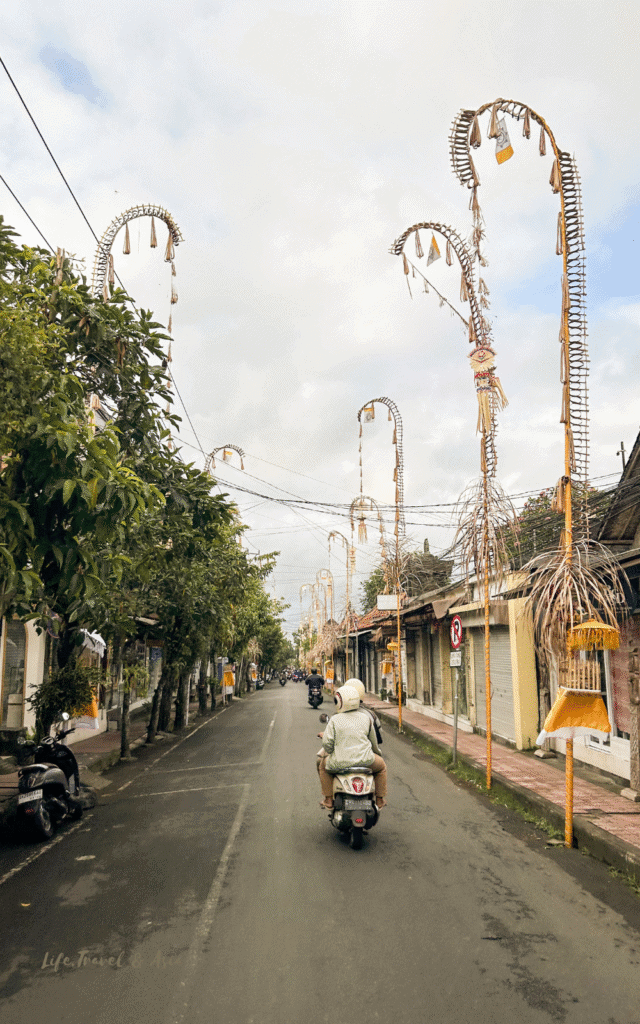
The other day, a Grab driver took a completely different route, and I ended up at the end of Jl. Sugriwa.
I realized how beautiful that road is — with penjor decorations, rows of red-leafed plants, and that unmistakable traditional village atmosphere right in the heart of Ubud.
So I highly recommend exploring all these little alleys — Jl. Goutama, Jl. Sugriwa, Jl. Jembawan — and honestly, wherever your steps take you.
4. From Jl. Bisma to The Rice Fields in Kedewatan
Last but definitely not least, I recommend taking this rice field walk toward the end of the day, around 5 pm.
From Jl. Bisma, walk toward the Penestanan stairs and climb up — it’s a bit of a workout, I’ll be honest. Once you reach the top, keep walking straight past a small fruit market and a few warungs.
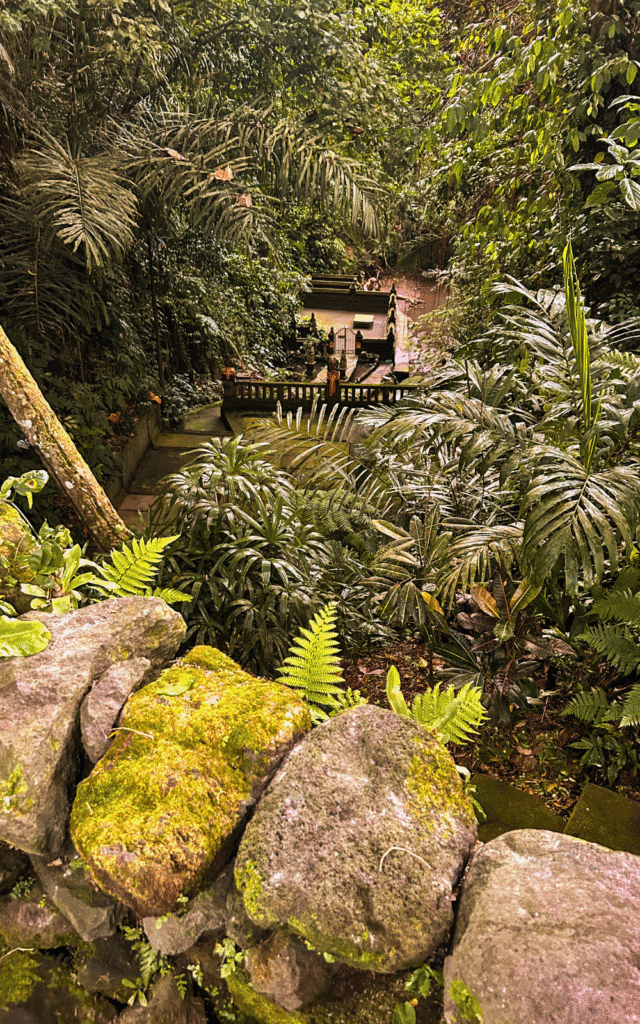
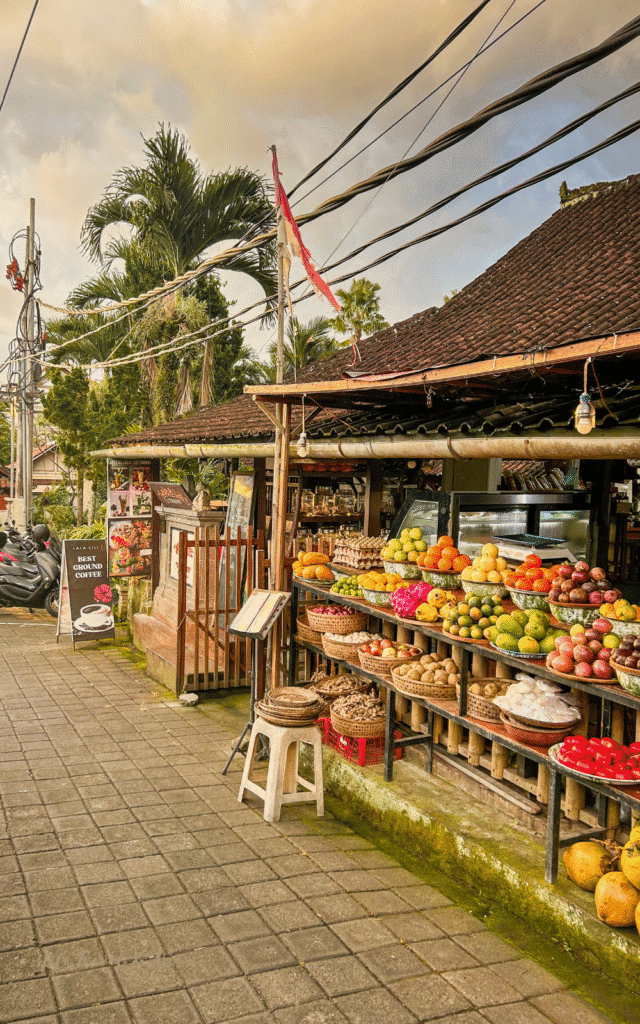
Soon you’ll find yourself descending into what feels like a hidden river valley, surrounded by trees.
On a tiny bridge, you’ll notice a few traditional Hindu altars, and if you look down toward the river on your left, you’ll spot a small shrine right by the riverbed.
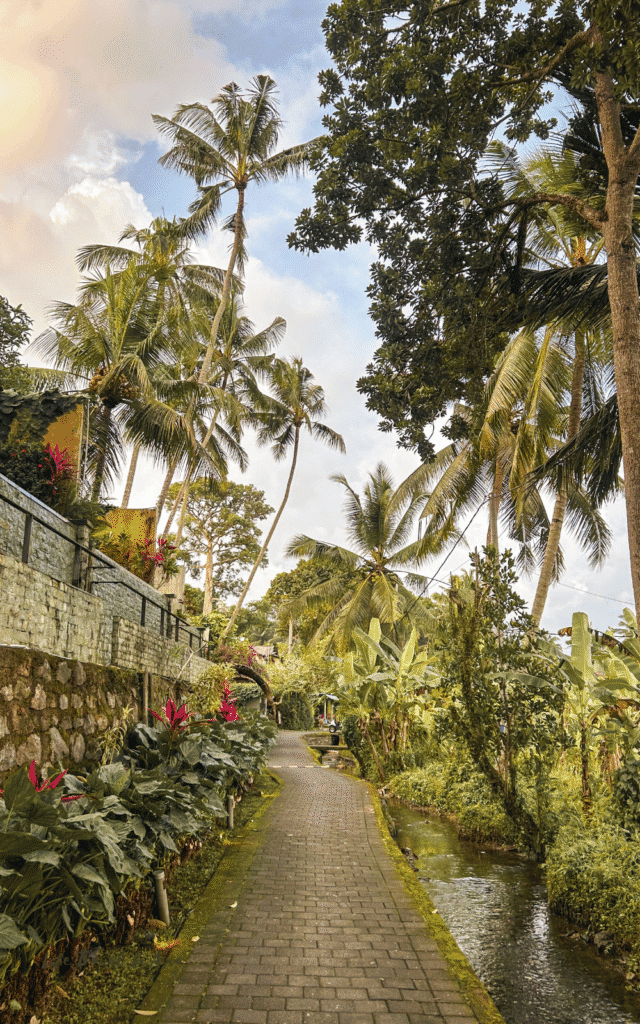
It’s honestly one of the most magical and secret corners of Ubud — locals come here to perform melukat, a traditional water purification ritual, and to meditate. The spiritual energy here is something you can truly feel.
After passing the river shrine, climb another short staircase and make it to the end of the road.
There, by turning right towards the end of the road, you’ll find what feels like a small local village — with a couple of laundries, warungs, a tiny market, some cafés, and the Penestanan Temple.
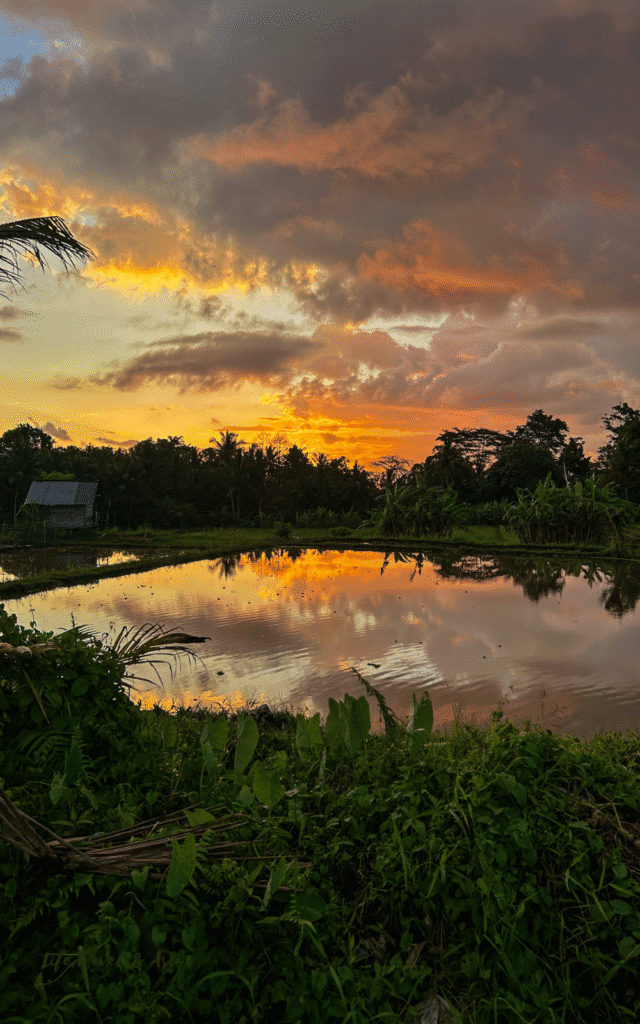
In front of you, there’s Warung Ting Ting. From there, turn left and walk until the end of the road, then turn right.
You’ll find a beautiful rice field path leading all the way to Jl. Raya Sangingan. It’s honestly one of the most stunning rice field walks in Ubud, and if you have the time, you shouldn’t miss it.
Practical Tips for Your Ubud Walking Tour
- When to go: Ubud can get really hot from around 12 to 3 pm, so it’s best to plan your walks either early in the morning or later in the afternoon (around 4–5 pm), when the light is softer and the air feels a bit cooler.
- What to bring: Depending on how much you’re planning to walk, bring a hat, sunscreen, and some water—though you’ll easily find small stalls and shops around Ubud if you need to grab a drink along the way.
- What to wear: Comfortable walking shoes or sandals. Some areas can be uneven or muddy after rain.
There you go! This is the Ubud walking tour I’d honestly recommend to anyone spending just one day in town — plus a few hidden spots I discovered during my daily walks. You’ll get to see the most popular sights while still feeling like you’ve truly experienced the real Ubud.
I truly believe that walking is the best way to feel a place, even if you only have a short time. And if you’re curious about other one-day itineraries in and around Ubud, check out my post linked just above.
On the other hand, if you have more time and are looking for more ideas, here you’ll also find my favorite things to do in Ubud, both the classic highlights and some unusual experiences I love.
So now it’s your turn — how long are you staying in Ubud? And what are you most excited to discover? Tell me in the comments below, and if you have any questions about this town I now call home, don’t hesitate to ask — I’d be happy to help!
Ubud Quick Guide
Spending more than one day in Ubud? Here are my top picks in town!
🌴 Best Rice Field Villa: Candy Villa
🛏️ Best Budget Stay in Ubud: Bisma Jaya Bungalow
Where to stay in Ubud: check out my guide to the best areas in town.
How many days in Ubud: From 3 to 5 days. Check out my Ubud itinerary for first-timers
🥗 Where to Eat in Ubud: Foodie’s Guide To Ubud Eats
📸 Favorite places to visit in Ubud: Rice fields, Gunung Kawi Sebatu Temple, and East Ubud Waterfalls.
Looking for more? Here’s my Ubud travel guide. You’ll find everything you need, from getting around to the best places to stay and things to do.
Did you find it helpful? 📌 Save it on Pinterest!
